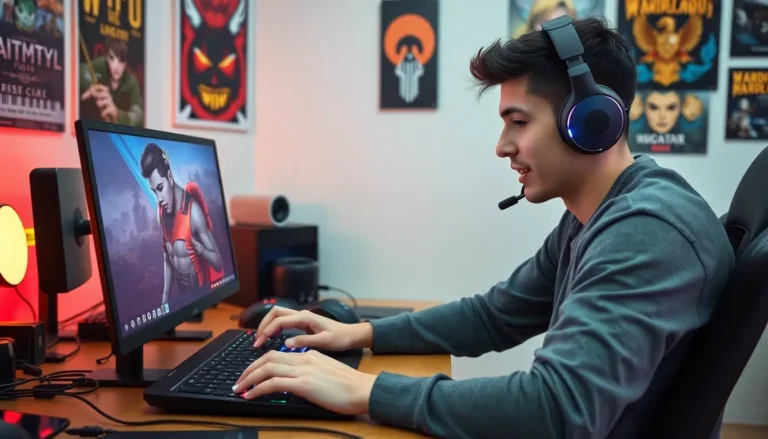Imagine floating weightlessly among the stars, dodging asteroids, and sipping space coffee without ever leaving your living room. Virtual reality for space isn’t just a sci-fi dream; it’s a thrilling new frontier that’s revolutionizing how we explore the cosmos. With cutting-edge technology, anyone can experience the wonders of the universe, from the comfort of their couch—no spacesuit required!
As the boundaries of reality blur, VR is transforming education, training, and entertainment in ways that are out of this world. It’s not just about gaming; it’s about immersing oneself in the vastness of space and unlocking the mysteries of the universe. Buckle up as we delve into how virtual reality is making space exploration accessible, engaging, and downright fun for everyone. Who knew the final frontier could be just a headset away?
Table of Contents
ToggleOverview of Virtual Reality for Space
Virtual reality (VR) technology creates immersive experiences that mimic real-life space exploration. Users can traverse celestial bodies, simulate weightlessness, and engage with cosmic phenomena. Several educational institutions leverage VR, allowing students to explore the solar system visually. These experiences enhance learning and provide interactive opportunities to grasp complex astronomical concepts.
Training astronauts also benefits from VR simulations. Agencies like NASA employ VR for mission preparation, enabling astronauts to rehearse procedures in simulated environments. One example is the use of VR to train for spacewalks, which is crucial for real missions. Such training can reduce risks and enhance performance during actual space missions.
Entertainment incorporates VR into space-themed applications and games. Developers create experiences that allow players to inhabit the role of space explorers, piloting spacecraft across galaxies. Users engage with stunning visuals and realistic soundscapes that heighten the sense of existence in a cosmic realm.
Research showcases potential therapeutic applications of VR for space experiences. Individuals with limited mobility or anxiety about space travel can benefit from simulated environments that provide a sense of freedom and exploration. Programs designed for this purpose increase accessibility to the wonders of space.
A growing number of VR platforms now offer content that focuses on space exploration. These platforms make it easy for users to access various experiences, from virtual tours of Mars to 3D models of distant galaxies. As technology improves, the quality and realism of these simulations will continue to advance, making virtual space exploration an invaluable resource for education, training, and entertainment.
Applications of Virtual Reality in Space Exploration
Virtual reality technology finds various applications in space exploration. The versatility of VR enhances multiple aspects of the field.
Astronaut Training
Agencies like NASA utilize VR to develop astronaut training programs. Trainees rehearse critical procedures in immersive environments that replicate actual space missions. Simulations include scenarios like spacewalks and emergency protocols. Astronauts gain hands-on experiences without the inherent risks of real space travel. Trainees enhance their performance, build confidence, and solidify teamwork through realistic training exercises. This practical approach fosters familiarity with equipment and enhances problem-solving skills in high-pressure situations. Evidence shows that VR training improves readiness for real-world challenges when deployed in space.
Mission Simulation
VR provides capabilities for effective mission simulations. It allows teams to engage with spacecraft controls and navigate complex interplanetary scenarios. Engineers can visualize missions before execution and address potential challenges. Realistic environments create a deeper understanding of mission dynamics and logistics. By simulating long-duration spaceflights, scientists can study psychological effects and resource management strategies in a controlled setting. This invaluable insight informs planning and resource allocation for actual missions. VR mission simulations streamline the preparation process, ensuring missions function smoothly and reliably.
Public Engagement and Education
VR serves as a powerful tool for public engagement in space exploration. Educational institutions incorporate VR to captivate students of all ages. Learners embark on virtual journeys through the solar system and beyond, exploring planets and celestial events. This strategy transforms abstract concepts into immersive experiences, fostering deeper understanding. Public demonstrations allow communities to connect with space science, inspiring the next generation of explorers. Users can experience simulated training scenarios that enhance awareness of astronaut challenges. Access to virtual environments elevates interest, promoting curiosity and expanding knowledge about our universe. Through these engaging experiences, VR reinforces the excitement and importance of space exploration.
Benefits of Virtual Reality for Space
Virtual reality technology provides numerous advantages for space exploration, offering enhanced experiences in various domains.
Enhanced Immersion
Immersive environments created by virtual reality allow users to feel as if they’re truly in space. Users can explore the solar system, walk on different celestial bodies, and experience weightlessness as if they were astronauts. This level of engagement facilitates deeper learning and understanding of complex scientific concepts. Educational institutions can utilize these VR experiences to captivate students, making astronomy more enjoyable. Researchers noted that enhanced immersion fosters curiosity about space, inspiring the next generation of scientists and explorers. As users delve into such simulations, they grasp the universe’s wonders through firsthand experiences. Comprehensive virtual environments thus enrich educational content and stimulate interest in space science.
Increased Safety
Virtual reality training offers a significant safety advantage for astronaut preparation. Astronauts engage in realistic simulations that replicate challenging scenarios without physical risks. This training method allows for rehearsal of high-stakes procedures like spacewalks, which requires precision and confidence. Effective training in virtual environments builds teamwork skills, enhancing overall mission readiness. Reduced physical risks afford astronauts the chance to focus on learning rather than worrying about possible hazards. Additionally, mission planners can test various strategies through VR, identifying best practices and solutions for complex situations. Safe practice environments established through VR ultimately lead to better-prepared astronauts for real-world missions.
Cost-Effectiveness
Implementing virtual reality solutions can lead to substantial cost savings. Traditional astronaut training involves expensive equipment, facilities, and logistics. Virtual reality drastically reduces the need for physical resources, leading to lower operational expenses. While developing these VR applications requires upfront investment, long-term savings can significantly benefit space organizations. This technology enables frequent training sessions without incurring high costs associated with real-life simulations. Additionally, VR experiences can be widely shared, maximizing access to space education. Agencies can reach larger audiences without the necessity for expensive physical platforms. Cost-effectiveness thus plays a crucial role in promoting wider adoption of VR in space exploration.
Challenges and Limitations
Virtual reality for space exploration faces several challenges and limitations. These factors impact its effectiveness and user engagement.
Technological Hurdles
VR technology often requires substantial hardware capabilities. High-resolution graphics and low latency systems contribute to immersive experiences. Limited access to advanced equipment constrains some users. Additionally, software development can lag behind hardware advancements, leading to compatibility issues. Inconsistent experiences across platforms may frustrate users. Reliability of tracking systems also poses a challenge, as any lag affects immersion. Overcoming these technological hurdles is vital for broader adoption in space exploration.
User Experience Concerns
User experience remains a critical focus in VR applications. Many individuals experience discomfort during extended sessions due to motion sickness or visual fatigue. Environments that lack user-friendly navigation can hinder exploration. User interface design plays a significant role in engagement; poorly designed interfaces detract from immersion. Moreover, accessibility issues may alienate users with disabilities. Tailoring VR experiences to diverse audiences enhances usability. Addressing these concerns improves overall satisfaction and encourages continued use.
Future Trends in Virtual Reality for Space
Innovations in virtual reality (VR) for space are set to reshape how exploration unfolds. Advances in realistic graphics create unparalleled immersive experiences, allowing users to feel as though they are floating in zero gravity. Real-time data integration can make simulations more accurate, bringing celestial events to life as they happen.
Collaborative VR platforms are emerging, enabling global teams to work together on space missions. Shared experiences in virtual environments facilitate training for astronauts while promoting international cooperation in exploration efforts. Educational institutions are increasingly integrating VR into their curriculums, engaging students with interactive lessons about astronomy and physics.
Furthermore, improvements in hardware technology enhance accessibility. Wireless VR headsets eliminate constraints, allowing users to explore without being tethered to a system. Increased affordability of development tools means more creators can develop unique VR experiences focused on space.
The flexibility of VR applications also extends to the field of therapy. Simulated space environments can help individuals manage anxiety and enhance their understanding of space travel. As therapeutic practices intertwine with VR, customized experiences may support diverse groups, including those with disabilities.
Enhanced social VR experiences are gaining traction within community settings. Virtual space camps foster collaboration among young learners, fostering interest in STEM fields. As community involvement grows, so does public engagement with space exploration initiatives.
Overall, VR technology continues to evolve, making access to space experiences more widespread. Continuous research and development are crucial for maintaining relevance and expanding capabilities. As innovations unfold, the impact of VR on space exploration will likely deepen, transforming how humanity interacts with the cosmos.
Virtual reality is revolutionizing the way people engage with space exploration. By making the cosmos accessible to everyone, it sparks curiosity and fosters a deeper understanding of our universe. As technology continues to advance, the experiences offered through VR will only become more immersive and realistic.
The benefits of VR extend beyond entertainment and education, enhancing astronaut training and promoting safety in high-stakes environments. While there are challenges to overcome, the potential for VR to transform space exploration is immense. As more users embrace this technology, the future of virtual space exploration looks bright, promising to inspire generations to look up and dream big.






